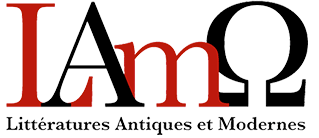The EDG (Ecole de Gaza – School of Gaza)
During the 5th and 6th centuries, Gaza was a city at the crossroads of civilisations – to use the title of a recent publication (Gaza à la croisée des civilisations, I. Contexte historique et archéologique, Neuchâtel-Genève, 2007) – and an extraordinary phenomenon of syncretism between Hellenism and Christianity emerged from among its aristocrats and scholars. The encounter of these two spheres, which seem incompatible from a rhetorical standpoint, must be linked to a wider movement known today as the Third Sophistic; this allowed the Palestinian city, at the height of its literary activity, to rival Athens as the cultural capital of the Empire. Indeed, against a backdrop of political troubles, exterior threats, internal strife and the hazards of nature, a privileged and unusual creative space emerged in and around the city. This intellectual hub was composed of clerks, of dignitaries and imperial officials, of poets and Christian intellectuals, all of whom were nourished by the ancient school of Rhetoric advocated by the famous teachers Procopius and Chorikios; it was named by K. B. Stark as the “School of Gaza” (K. B. Stark, Gaza und die philistäische Küste, Jena 1852).
The School of Gaza was a genuine, flourishing literary movement with its own institution, students, rules, and rising stars. As a school of thought, it was rooted within a historic continuum and established itself not only as a tribute to Athens’ glorious past but also as a witness to the realities of the Proto-Byzantine empire. It echoed the main theological, philosophical, and moral questions of the age, as well as the daily preoccupations of Gaza’s inhabitants. Thus, as a movement, it deserves to be recognised fully in historical and literary studies.
In the field of Late Antiquity, these last few years have borne witness to a growing interest in the School of Gaza: archaeologists, historians and philologists have ceaselessly re-examined the large amount of information left to us by ancient writers in their works, and further enriched this corpus through the discovery of unpublished manuscripts. In 2004, B. Bitton-Ashkelony and A. Kofsky edited a collection of thirteen papers on the subject; their aim was to paint a vivid portrait of the city of Gaza’s history in Late-Antiquity, with an emphasis on its Christian history (B. Bitton-Ashkelony et A. Kofsky [éd.], Christian Gaza in Late Antiquity, Leiden-Boston, 2004). Three seminars centred around this question have also taken place recently: the first was in Poitiers (6th-7th May 2004) under the direction of C. Saliou (Gaza dans l’Antiquité Tardive. Archéologie, Rhétorique, Histoire. Actes du colloque international de Poitiers (6-7 mai 2004) , édités par C. Saliou, Salerno, 2005); a second seminar was organised by E. Amato, A. Corcella and D. Lauritzen in Paris, at the Collège de France (23-25 May 2013); the third took place in Nantes (6 June 2014) under the guidance of E. Amato, M. Deroma et L. Thévenet (Discorso pubblico e declamazione scolastica a Gaza nella tarda antichità : Coricio di Gaza e la sua opera. Atti della giornata di studio, Nantes 6 giugno 2014, a cura di E. Amato, L. Thévenet, G. Ventrella, Bari, 2014). Recently, the publication of Procopius of Gaza’s completed works in the “Collection des Universités de France” opened up a vast new field of research, chiefly including – with the support of the Institut Universitaire de France – a new French edition of the works of Choricius in the same collection. This undertaking is just one of many ongoing research projects focused on various aspects of the School of Gaza and on its many authors, who count among their numbers John, Aeneas, Timotheus, and the desert monks, the role of whom should not be underestimated.
Today, an international research team has been set up under the aegis of E. Amato (University of Nantes and Institut Universitaire de France) and A. Corcella (Università della Basilicata); it is composed of members, professors and doctoral students, all of whom are combining their enthusiasm and their specific skills so as to fill the gaps that are still preventing us from fully understanding this cultural movement. Sponsored by the Institut Universitaire de France, the University of Nantes – including the laboratory EA 4276 “The Ancient, the Modern” (AMo) – and the Pays de la Loire region, the team is committed to widening our knowledge of the School of Gaza, particularly through the organisation of seminars and study days, as well as by publishing articles and collections of reports brought together on a specialised webpage.
The website, entitled “ecoledegaza.fr,” is the first official site dedicated to the School of Gaza during the Late Antiquity period. Supported by the Institut Universitaire de France, it was designed and administered by members of our research team. Its aim is to be an open, constantly-updated broadcast medium to share the progress of our research: biographies, lists of manuscripts, prosopography, updated bibliographies and downloadable documents are all available (with the use of an access code). The main motivation for this website is to reflect our team’s aspirations and passions – you may discover more about them on the members’ page. The website is also a dynamic platform on which researchers from all countries may share their information. To further this goal, a contact form is at your disposal, enabling you to tell us about your experiences, research, discoveries, and suggestions.
Lastly, the doors to the School of Gaza are open for all: whether you are an amateur, a lover of literature or history, or simply a curious spirit, the website’s administrators wish you a pleasant and enriching read!
More information at: http://ecoledegaza.fr/


























